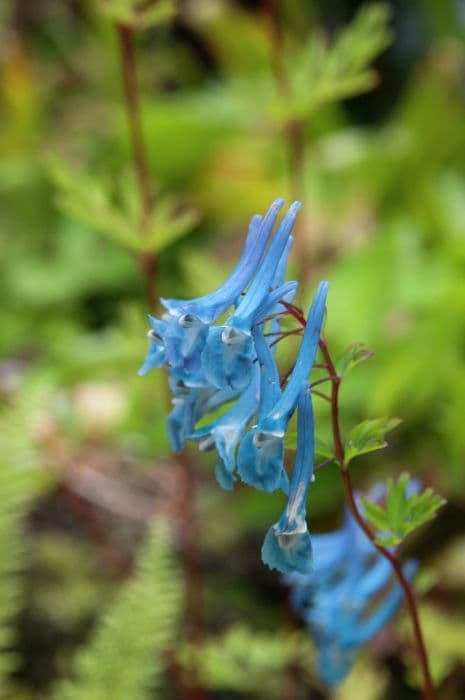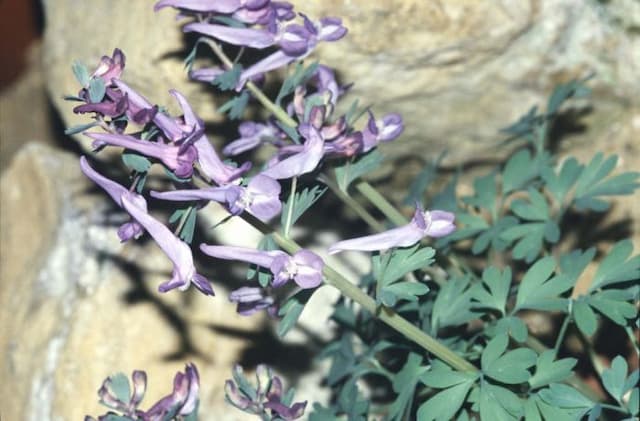California poppy 'Ivory Castle' Eschscholzia californica 'Ivory Castle'

ABOUT
'Ivory Castle' is a bushy annual to about 35cm with finely divided, blue-green foliage and single, creamy-white flowers in summer
About this plant
 Names
NamesFamily
Papaveraceae
Synonyms
California Poppy, Golden Poppy, California Sunlight, Cup of Gold
Common names
Eschscholzia californica 'Ivory Castle'.
 Characteristics
CharacteristicsLife cycle
Perennials
Foliage type
Deciduous
Color of leaves
Blue-green
Flower color
Ivory
Height
1 foot (30 cm)
Spread
1 foot (30 cm)
Plant type
Herb
Hardiness zones
8
Native area
California
Benefits
 General Benefits
General Benefits- Aesthetic Appeal: The 'Ivory Castle' variant of Eschscholzia californica, commonly known as California Poppy, features distinctive ivory-white flowers that add a unique visual interest to gardens and landscapes.
- Drought Tolerance: As a native of arid environments, California Poppy is well-adapted to survive in drought conditions, reducing the need for frequent watering.
- Low Maintenance: California Poppy is known for requiring minimal upkeep, with no need for fertilization and only occasional trimming after flowering.
- Pollinator Attraction: The blooms of the California Poppy are attractive to bees and other pollinators, which helps support the local ecosystem.
- Erosion Control: Its root system helps stabilize the soil, making it a good choice for sloped areas and preventing soil erosion.
- Edible Uses: The leaves and flowers of Eschscholzia californica are edible and can be used in salads or as a garnish, though caution is advised as the plant can have sedative effects.
- Adaptability: California Poppy is highly adaptable and can thrive in a variety of soil types, from sandy to loamy, as long as the soil is well-draining.
- Self-seeding: It is capable of self-seeding under suitable conditions, ensuring a continuous display of flowers in subsequent years with little effort.
- Habitat Enrichment: By including native plants like the California Poppy in landscaping, gardeners can enrich local habitats, providing better support for indigenous wildlife.
 Medical Properties
Medical Properties- Analgesic: California poppy has traditionally been used to alleviate pain.
- Anxiolytic: The plant is sometimes used for its anxiety-reducing effects.
- Sedative: It may act as a mild sedative, helping to improve sleep.
- Antispasmodic: California poppy contains compounds that can help relieve muscle spasms.
 Air-purifying Qualities
Air-purifying QualitiesThis plant is not specifically known for air purifying qualities.
 Other Uses
Other Uses- The California poppy 'Ivory Castle' can be used as a natural dye for fabrics, providing a subtle yellow to ivory hue depending on the mordant used.
- Its petals can be tossed into salads for an edible garnish that offers a mild, vegetal flavor and a pop of color.
- The dried seed pods of the California poppy can be incorporated into floral arrangements for unique textural interest.
- These plants are useful in xeriscaping, a landscaping approach that requires little to no irrigation, thus conserving water resources.
- California poppies can act as a cover crop in the off-season, helping to suppress weeds and reduce soil erosion.
- The blossoms and foliage can be used in the art of photogram making, where they are placed on photosensitive paper to create silhouettes when exposed to light.
- Its seeds can be used in crafts, like seed art or for making natural jewelry, as they have a distinctive appearance.
- These hardy plants can be used to stabilize slopes and banks, helping to prevent landslides and soil loss.
- The California poppy is also an indicator plant, which can signal through its growth the health of a particular ecosystem, especially in its native range.
- It can be planted in urban gardens to bring a touch of wildflower beauty and to support urban biodiversity, attracting pollinators like bees and butterflies.
Interesting Facts
 Feng Shui
Feng ShuiThe California poppy is not used in Feng Shui practice.
 Zodiac Sign Compitability
Zodiac Sign CompitabilityThe California poppy is not used in astrology practice.
 Plant Symbolism
Plant Symbolism- California Poppy: Eschscholzia californica 'Ivory Castle', more commonly known as the California Poppy, often symbolizes sleep, peace, and death due to its sedative effects and its use in traditional remedies to induce sleep. The association with death may also be due to poppies' prominence in fields where battles were fought in wars, becoming a remembrance symbol.
- Beauty and Resilience: The delicate appearance of the California Poppy, combined with its ability to thrive in harsh conditions, represents beauty and resilience. It can grow in poor soil and dry climates, symbolizing the capacity to flourish despite adversity.
- California State Flower: As the state flower of California, it stands for pride and admiration specific to the state. It’s a symbol of the region's natural beauty and is celebrated every year on California Poppy Day.
- Transience: The California Poppy's brief blooming period is often seen as a symbol of transience, representing the fleeting nature of life.
 Water
WaterCalifornia Poppy 'Ivory Castle' is drought-tolerant and prefers to be watered sparingly. Established plants should be watered deeply but infrequently, allowing the soil to dry out completely between waterings. A good rule of thumb is to provide about one inch of water every 7 to 10 days during the growing season, ensuring the water penetrates the soil to reach the roots. Overwatering or keeping the soil moist can lead to root rot, so monitoring the soil moisture beforehand is crucial. In cooler months or climates, reduce watering to match the plant's reduced growth and evaporation rates.
 Light
LightCalifornia Poppy 'Ivory Castle' thrives in full sun exposure, where it can receive at least six hours of direct sunlight daily. It's ideal to plant it in a spot that is sheltered from strong winds but still provides plenty of bright light. Too much shade can result in weak growth and fewer blooms.
 Temperature
TemperatureCalifornia Poppy 'Ivory Castle' can tolerate a wide range of temperatures but grows best in temperatures between 50°F and 75°F. It is hardy in temperatures as low as 32°F, making it frost tolerant, and it can survive in temperatures up to about 100°F though extreme heat may stress the plant. Providing some afternoon shade in hotter areas can help prevent overheating and protect the plant.
 Pruning
PruningCalifornia Poppy 'Ivory Castle' benefits from deadheading spent flowers to encourage more blooms and to prevent self-sowing if not desired. Prune or pinch off the faded blooms regularly during the flowering season. There is no need for heavy pruning, but removing dead or dying foliage can help maintain plant health and appearance.
 Cleaning
CleaningAs needed
 Soil
SoilCalifornia Poppy 'Ivory Castle' thrives in well-draining soil with low fertility; a mix of sand, loamy soil, and compost works well. They prefer a soil pH between 6.0 to 7.5.
 Repotting
RepottingCalifornia Poppies, being annuals or short-lived perennials, do not typically require repotting. They are often sown directly where they are to flower.
 Humidity & Misting
Humidity & MistingCalifornia Poppy 'Ivory Castle' is tolerant of a range of humidity levels and does best in dry to moderate humidity conditions typical of its native environment.
 Suitable locations
Suitable locationsIndoor
Provide full sunlight and minimal watering for indoor California Poppies.
Outdoor
Plant in full sun, well-draining soil; minimal water once established.
Hardiness zone
6-10 USDA
 Life cycle
Life cycleThe life of the California Poppy 'Ivory Castle' begins with seed germination, which requires well-draining soil and occurs when environmental conditions like temperature and moisture are appropriate. Following germination, the seedling develops its first true leaves and continues to grow, establishing a deep taproot. As the plant enters the vegetative growth stage, it produces a rosette of bluish-green foliage, followed by flowering stems as it matures. The blooming stage showcases the plant's distinct ivory white petals, usually from early spring to late summer, depending on the climate. After pollination, possibly by bees or other insects, the flowers will produce slender seed pods that eventually dry and release seeds back into the soil. The California Poppy 'Ivory Castle' can complete its life cycle in one growing season, behaving as an annual, or may survive through mild winters in warmer regions, acting as a perennial.
 Propogation
PropogationPropogation time
Spring to Early Summer
California poppy 'Ivory Castle' is predominantly propagated through seeds. The best time to sow these seeds is in the fall or early spring, directly into the garden where they are to grow. They require light to germinate, so simply scatter the seeds on the surface of the soil and press them down lightly without covering them. The seeds generally germinate within two weeks as long as the soil temperatures are around 60 to 70 degrees Fahrenheit (15.6 to 21.1 degrees Celsius). Thin the seedlings to about 6 to 12 inches (15 to 30 centimeters) apart once they have a few sets of true leaves. Since California poppies have a taproot system, they do not transplant well, making direct seeding the most practical and successful method for garden propagation.









